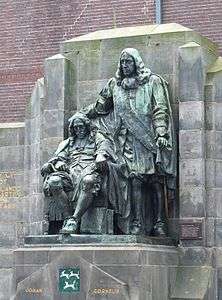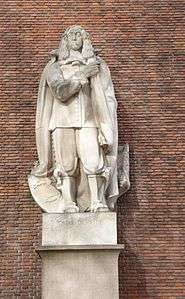Johan de Witt
| Johan de Witt | |
|---|---|
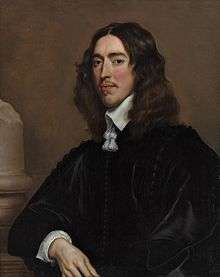 Portrait by Adriaen Hanneman, 1652 | |
| Grand Pensionary of Holland | |
|
In office 30 July 1653 – 4 August 1672 | |
| Preceded by | Adriaan Pauw |
| Succeeded by | Gaspar Fagel |
| Pensionary of Dordrecht | |
|
In office 21 December 1650 – 30 July 1653 | |
| Preceded by | Nicolaas Ruys |
| Succeeded by | Govert van Slingelandt |
| Personal details | |
| Born |
Johan de Witt 24 September 1625 Dordrecht, Holland, Dutch Republic |
| Died |
20 August 1672 (aged 46) The Hague, Holland, Dutch Republic |
| Spouse(s) | Wendela Bicker |
| Relatives |
|
| Alma mater | Leiden University |
Johan de Witt or Jan de Witt, heer van Zuid- en Noord-Linschoten, Snelrewaard, Hekendorp and IJsselveere[1] (24 September 1625 – 20 August 1672) was a key figure in Dutch politics in the mid-17th century, when its flourishing sea trade in a period of globalisation made the United Provinces a leading European power during the Dutch Golden Age. De Witt controlled the Netherlands political system from around 1650 until shortly before his death in 1672, working with various factions from nearly all the major cities, especially his hometown, Dordrecht, and the hometown of his wife, Amsterdam.
As a republican he opposed the House of Orange-Nassau. He was also strongly liberal, preferring lesser power to the central government and more power to the regenten. However, his negligence of the Dutch land army (as the regents focused only on merchant vessels, thinking they could avoid war) proved disastrous when the Dutch Republic suffered numerous early defeats in the Rampjaar (1672). In the hysteria that followed the effortless invasion by an alliance of three countries, he and his brother Cornelis de Witt were blamed and lynched in The Hague, whereafter rioters partially ate the brothers.[2][3][4] The rioters were never prosecuted,[5] and historians have argued that William of Orange may have incited them.[6]
Early years
Early life and education
Johan de Witt was a member of the old Dutch patrician family De Witt. His father was Jacob de Witt, an influential regent and burgher from the patrician class in the city of Dordrecht, which in the seventeenth century, was one of the most important cities of the dominating province of Holland. Johan and his older brother, Cornelis de Witt, grew up in a privileged social environment in terms of education, his father having as good acquaintances important scholars and scientists, such as Isaac Beeckman, Jacob Cats, Gerardus Vossius and Andreas Colvius. Johan and Cornelis both attended the Latin school in Dordrecht, which imbued both brothers with the values of the Roman Republic.
After having attended the Latin school in Dordrecht, he studied at the Leiden University, where he excelled at mathematics and law. He received his doctorate from the University of Angers in 1645. He practiced law as a lawyer in The Hague as an associate with the firm of Frans van Schooten. In 1650 (the year that stadtholder William II, Prince of Orange died) he was appointed leader of the deputation of Dordrecht to the States of Holland and West Friesland. In December 1650, De Witt became the pensionary of Dordrecht.[9] Once during the year 1652 in the city of Flushing, Johan De Witt found himself faced with a mob of angry demonstrators of sailors and fishermen. An ugly situation was developing.[10] However, even at the young age of 27 years, it was Johan's coolheadedness that calmed the situation. Many people older than Johan began to see greatness in Johan dating from that experience.
Marriage and children
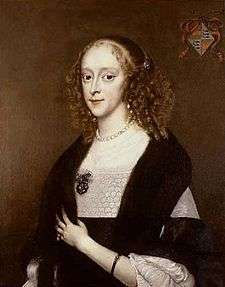
Johan de Witt married on 16 February 1655 Wendela Bicker (1635–1668), the daughter of Jan Bicker (1591–1653), an influential patrician from Amsterdam, and Agneta de Graeff van Polsbroek (1603–1656). Jan Bicker served as mayor of Amsterdam in 1653. De Witt became a relative to the strong republican-minded brothers Cornelis and Andries de Graeff, and to Andries Bicker. The couple had four children, three daughters and one son:[11]
- Anna de Witt (1655–1725), married to Herman van den Honert
- Agnes de Witt (1658–1688), married to Simon Teresteyn van Halewijn
- Maria de Witt (1660–1689), married to Willem Hooft
- Johan de Witt Jr. (1662–1701), heer van Zuid- en Noord-Linschoten, Snelrewaard and IJsselveere, married to Wilhelmina de Witt. He was secretary of the city of Dordrecht
After De Witt's death, his brother in law Pieter de Graeff became a guardian over his children.[12]
Grand Pensionary
In 1653, the States of Holland elected De Witt councilor pensionary (in Dutch raadpensionaris). Since Holland was the Republic's most powerful province, he was effectively the political leader of the United Provinces as a whole—especially during periods when no stadholder had been elected by the States of most Provinces. The raadpensionaris of Holland was often referred to as the Grand Pensionary by foreigners as he represented the preponderant province in the Union of the Dutch Republic. He was a servant who led the States of province by his experience, tenure, familiarity with the issues, and use of the staff at his disposal. He was in no manner equivalent to a modern Prime Minister.[13] · [14]
Representing the province of Holland, Johan De Witt tended to identify with the economic interests of the shipping and trading interests in the United Provinces. These interests were largely concentrated in the province of Holland, and to a lesser degree in the province of Zeeland.[15] In the religious conflict between the Calvinists and the more moderate members of the Dutch Reformed Church that arose in 1618,[16] Holland tended to belong to the more tolerant Dutch Reformed faction in the United Provinces. Not surprisingly, Johan de Witt also held views of toleration of religious beliefs.
Act of Seclusion

De Witt's power base was the wealthy merchant class into which he was born. This class broadly coincided politically with the "States faction", stressing Protestant religious moderation and pragmatic foreign policy defending commercial interests. The "Orange faction", consisting of the middle class, preferred a strong leader from the Dutch Royal House of Orange as a counterweight against the rich upper-classes in economic and religious matters alike. Although leaders that did emerge from the House of Orange rarely were strict Calvinists themselves, they tended to identify with Calvinism,[18] which was popular among the middle classes in the United Provinces during this time. William II of Orange was a prime example of this tendency among the leaders of the House of Orange to support Calvinism. William II was elected Stadholder in 1647 and continued to serve until his death in November, 1650.[19] Eight days after his death, William II's wife delivered a male heir--William III of Orange. Many citizens of the United Provinces urged the election of the infant William III as stadholder under a regency until he came of age. However, the Provinces, under the dominance of the province of Holland[20] did not fill the office of Stadholder.
Together with his uncle, Cornelis de Graeff, Johan De Witt brought about peace with England after the First Anglo-Dutch War with the Treaty of Westminster in May 1654.[21] The peace treaty had a secret annex, the Act of Seclusion, forbidding the Dutch ever to appoint William II's posthumous son, the infant William, as stadholder. This annex had been attached on instigation of Cromwell, who felt that since William III was a grandson of the executed Charles I, it was not in the interests of his own republican regime to see William ever gain political power. On 25 September 1660 the States of Holland under the prime movers of De Witt, Cornelis de Graeff, his younger brother Andries de Graeff and Gillis Valckenier resolved to take charge of William's education to ensure he would acquire the skills to serve in a future—though undetermined—state function.[22] Influenced by the values of the Roman republic, De Witt did his utmost anyway to prevent any member of the House of Orange from gaining power, convincing many provinces to abolish the stadtholderate entirely. He bolstered his policy by publicly endorsing the theory of republicanism. He is supposed to have contributed personally to the Interest of Holland, a radical republican textbook published in 1662 by his supporter Pieter de la Court.[23]
In the period following the Treaty of Westminster, the Republic grew in wealth and influence under De Witt's leadership. De Witt created a strong navy, appointing one of his political allies, Lieutenant-Admiral Jacob van Wassenaer Obdam, as supreme commander of the confederate fleet.[24] Later De Witt became a personal friend of Lieutenant-Admiral Michiel de Ruyter.
Perpetual Edict
The Second Anglo-Dutch War began in 1665, lasting until 1667 when it ended with the Treaty of Breda, in which De Witt negotiated very favorable agreements for the Republic after the partial destruction of the English fleet in the Raid on the Medway, initiated by De Witt himself and executed in 1667 by De Ruyter.
At about the time the Treaty of Breda was concluded, De Witt made another attempt at pacification of the quarrel between States Party and Orangists over the position of the Prince of Orange. He proposed to have William appointed captain-general of the Union on reaching the age of majority (23); on condition, however, that this office would be declared incompatible with that of stadtholder in all of the provinces. For good measure the stadtholderate was abolished in Holland itself. This Perpetual Edict (1667) was enacted by the States of Holland on 5 August 1667, and recognised by the States General on a four-to-three vote in January, 1668. This edict was added by Gaspar Fagel, then Pensionary of Haarlem, Gillis Valckenier and Andries de Graeff, two prominent Amsterdam regents, which abolished the stadtholderate in Holland "for ever".
Year of Disaster
.jpg)
During 1672, which the Dutch refer to as the Rampjaar ("Year of Disaster"), France and England attacked the Republic in the Franco-Dutch War. De Witt was severely wounded by a knife-wielding assassin on 21 June. He resigned as Grand Pensionary on 4 August, but this was not enough for his enemies. His brother Cornelis (De Ruyter's deputy-in-the-field at the Raid on the Medway), particularly hated by the Orangists, was arrested on trumped up charges of treason. He was tortured (as was usual under the Roman-Dutch system of law, that required a confession before a conviction was possible) but refused to confess. Nevertheless, he was sentenced to exile. When his brother went over to the jail (which was only a few steps from his house) to help him get started on his journey, both were attacked by members of The Hague's civic militia in a clearly orchestrated assassination. The brothers were shot and then left to the mob. Their naked, mutilated bodies were strung up on the nearby public gibbet, while the Orangist mob partook of their roasted livers in a cannibalistic frenzy. Throughout it all, a remarkable discipline was maintained by the mob, according to contemporary observers, making one doubt the spontaneity of the event.[25]
Thus ended the life of Johan de Witt, who had in effect ruled the Republic for almost twenty years. His regime outlasted him only a few more days. Though no more people were killed, the lynching of De Witts lent renewed impetus to the mob attacks, and to help restore public order the States of Holland empowered William on 27 August to purge the city councils in any way he would see fit to restore public order. The following purges in the early days of September were accompanied by large, but peaceful, Orangist demonstrations, that had a remarkable political character. The demonstrations delivered petitions that demanded certain additional reforms with a, in a sense, "reactionary" flavor: the "ancient" privileges of the guilds and civic militias (who were traditionally seen as mouthpieces of the citizenry as a whole) to curb the regent's powers were to be recognised again (as in pre-Burgundian times). The demonstrators also demanded more influence of the Calvinist preachers on the content of government policies and a roll-back of the toleration of Catholics and other dissenting denominations. The purges of the city governments were not everywhere equally thoroughgoing (and, of course, there was little mention of popular influence later on, as the new regents shared the abhorrence of the old ones of real democratic reforms). But as a whole, the new Orangist regime of the Stadtholder was well-entrenched during his following reign.[26]
The question whether William had a hand in the murder of the De Witt brothers will always remain unanswered, like his exact role in the later Massacre of Glencoe. The fact that he ordered the withdrawal of a federal cavalry detachment, that otherwise might have prevented the lynching, has always raised eyebrows, however, like the fact that he did not prosecute the well-known ringleaders like Cornelis Tromp and his relative, Johan Kievit, the Buat conspirator, who now was appointed pensionary of Rotterdam, and even advanced their careers. But maybe firm measures against the conspirators were not feasible in the political climate of those fraught days in the Fall of 1672. In any case, the political turmoil did not enable the allies an opportunity to finish the Republic off. The French were effectively stymied by the water defenses. Only when the inundations froze over in the following winter was there, briefly, a chance for Marshal Luxembourg, who had taken over command of the invading army from Louis, to make an incursion with 10,000 troops on skates. This almost ended in disaster, when they were ambushed. Meanwhile, the States General managed to conclude alliances with the German emperor and Brandenburg, which helped relieve the French pressure in the East.[27][28]
Mathematician
Besides being a statesman, Johan de Witt also was an accomplished mathematician. In 1659 he wrote "Elementa Curvarum Linearum" as an appendix to Frans van Schooten's translation of René Descartes' La Géométrie. In this, De Witt derived the basic properties of quadratic forms, an important step in the field of linear algebra.
In 1671 his Waardije van Lyf-renten naer Proportie van Los-renten was published ('The Worth of Life Annuities Compared to Redemption Bonds'). This work combined the interests of the statesman and the mathematician. Ever since the Middle Ages, a Life annuity was a way to "buy" someone a regular income from a reliable source. The state, for instance, could provide a widow with a regular income until her death, in exchange for a 'lump sum' up front. There were also Redemption Bonds that were more like a regular state loan. De Witt showed - by using probability mathematics - that for the same amount of money a bond of 4% would result in the same profit as a Life Annuity of 6% (1 in 17). But the 'Staten' at the time were paying over 7% (1 in 14). The publication about Life Annuities is seen as the first mathematical approach of chance and probability. After the violent deaths of the brothers the 'Staten' issued new Life Annuities in 1673 for the old rate of 1 in 14.
In 1671 De Witt conceived of a life annuity as a weighted average of annuities certain where the weights were mortality probabilities (that sum to one), thereby producing the expected value of the present value of a life annuity. Edmond Halley’s (of comet fame) representation of the life annuity dates to 1693, when he re-expressed a life annuity as the discounted value of each annual payment multiplied by the probability of surviving long enough to receive the payment and summed until there are no survivors. De Witt's approach was especially insightful and ahead of its time. In modern terminology, De Witt treats a life annuity as a random variable and its expected value is what we call the value of a life annuity. Also in modern terminology, De Witt's approach allows one to readily understand other properties of this random variable such as its standard deviation, skewness, kurtosis, or any other characteristic of interest.
Legacy
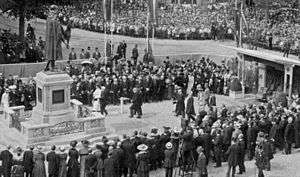
Currently one Dutch warship is named after Johan De Witt. HNLMS Johan de Witt (L801) is an amphibious Landing Platform Dock vessel from the Rotterdam Class LPD.
Additionally, three statues of Johan de Witt can be found in the Netherlands.
In popular culture
The lynching of the De Witt brothers is depicted with a dramatic intensity in the first four chapters of The Black Tulip, a historical fiction novel written by Alexandre Dumas, père in 1850, and this event has implications for the whole plot line of the book.
In its time, Dumas's book helped make this tragedy known to a French readership (and a readership in other countries into whose languages the book was translated) who were otherwise ignorant of Dutch history.
The important role of Johan de Witt in Dutch politics and his murder was subject of the 2015 film Michiel de Ruyter, called The Admiral in the English version.
References
- ↑ Johan de Witt at Heren van Holland (in Dutch)
- ↑ [Herbert H. Rowen, John de Witt, Grand Pensionary of Holland, 1625-1672. Princeton, N.J.: Princeton University Press, 1978]
- ↑ [New York Times, August 21, 2005]
- ↑ Byrne, Eugene. "Is it true that an angry mob of Dutchmen killed and ate their own prime minister in 1672?". HistoryExtra.
- ↑ Byrne, Eugene. "Is it true that an angry mob of Dutchmen killed and ate their own prime minister in 1672?". HistoryExtra.
- ↑ Rowen, Herbert Harvey (2015). John de Witt, Grand Pensionary of Holland, 1625-1672. Princeton University Press. p. 891. ISBN 978-1-4008-7091-2.
- ↑ Rietstap, Johannes Baptist (1861). Armorial général, contenant la description des armoiries des familles nobles et patriciennes de l'Europe: précédé d'un dictionnaire des termes du blason. G.B. van Goor. p. 1135.
- ↑ BUNEL, Arnaud. "Héraldique européenne, Provinces-Unies et Royaume des Pays-Bas, Stadhouders et Souverains des Pays-Bas". Retrieved 8 July 2011.
- ↑ Jonathan I. Israel, The Dutch Republic: Its Rise, Greatness and Fall 1477-1806 (Oxford, England: Oxford University Press, 1995) p. 712.
- ↑ Jonathan I. Israel, The Dutch Republic: Its Rise, Greatness and Fall, 1477- 1806, p. 719.
- ↑ Anna de Witt at Heren van Holland (in Dutch)
- ↑ Rowen, Herbert H. John de Witt, Statesman of the True Freedom (Cambridge University Press 1986, New edition 2002), page 220
- ↑ Rowen, Herbert H. (1978). John de Witt, grand pensionary of Holland, 1625-1672. Princeton University Press. p. 59.
- ↑ Temple, Sir William (1705), Observations upon the United Provinces of the Netherlands, orig published 1668 (7th ed.), London: Jacob Tonfon within Grays-Inn Gate next Grays-Inn Lane, and Awnfoam and John Churchill at the Black Swan in Tater-No/ler-Row*, p. 104-105
- ↑ Jonathan Israel, The Dutch Republic: Its Rise, Greatness and Fall, 1477-1806, p. 467.
- ↑ Jonathan I. Israel, The Dutch Republic: Its Rise, Greatness and Fall, 1477-1806, pp. 450-477.
- ↑ The Threatened Swan, Jan Asselijn, c. 1650, Rijksmuseum. Retrieved on 15 January 2015.
- ↑ Jonathan I. Israel, The Dutch Republic: Its Rise, greatness and Fall, 1477-1806, p. 600.
- ↑ Jonathan I. Israel, The Dutch Republic: Its Rise, Greatness and Fall 1477-1806, p. 702.
- ↑ Jonathan I. Israel, The Dutch Republic: Its Rise, Greatness and Fall 1477-1806, p. 733.
- ↑ Jonathan I. Israel, The Dutch Republic: Its Rise, Greatness and Fall 1477-1806, p. 722.
- ↑ Troost, 43
- ↑ Jonathan I. Israel, The Dutch Republic, Its Rise, Greatness and Fall 1477-1806, pp. 759-760.
- ↑ Jonathan I. Israel, The Dutch Republic: Its Rise, Greatness and Fall 1477-1806, p. 721.
- ↑ Israel (1995), p. 803
- ↑ Israel (1995), pp. 804-806
- ↑ Een wijnkoper, een herbergier en diens slager doodden Johan de Witt in 1672
- ↑ Israel (1995), p. 812
Literature
- Herbert H. Rowen, John de Witt, Grand Pensionary of Holland, 1625-1672. Princeton, N.J.: Princeton University Press, 1978, which is summarized in
- Herbert H. Rowen, "John de Witt: Statesman of the "True Freedom"". Cambridge University Press, 2003.
- Herbert H. Rowen, The Princes of Orange: the Stadholders in the Dutch Republic. Cambridge and New York: Cambridge University Press, 1988.
- Herbert H. Rowen, The Princes of Orange: the Stadholders in the Dutch Republic. Cambridge and New York: Cambridge University Press, 2003.
- Petrus Johannes Blok, "History of the People of the Netherlands". New York: G. P. Putnam's sons, 1898.
- Pieter Geyl, "Orange and Stuart, 1641-1672". Scribner, 1970.
- Jonathan I. Israel, "The Dutch Republic: Its Rise, Greatness, and Fall, 1477–1806" Oxford University Press, 1995. ISBN 0-19-820734-4
- Peter de la Court: de la Court, Peter (1746) [1662]. MEMOIRS OF Cornelius de Witt and John de Witt, - Pieter de la Court, The True Interest and Political Maxims, of the Republic of Holland. London: London: John Campbell, Esq,. Retrieved October 18, 2011.
External links
| Wikimedia Commons has media related to Johan de Witt. |
| Wikisource has original text related to this article: |
| Wikisource has original text related to this article: |
- The Project Gutenberg EBook of History of Holland, by George Edmundson
- O'Connor, John J.; Robertson, Edmund F., "Johan de Witt", MacTutor History of Mathematics archive, University of St Andrews.
- Johan de Witt at the Mathematics Genealogy Project
- Friends of De Witt (in Dutch)
| Political offices | ||
|---|---|---|
| Preceded by Nicolaas Ruys |
Pensionary of Dordrecht 1650–1653 |
Succeeded by Govert van Slingelandt |
| Preceded by Adriaan Pauw |
Grand Pensionary of Holland 1653–1672 |
Succeeded by Gaspar Fagel |

